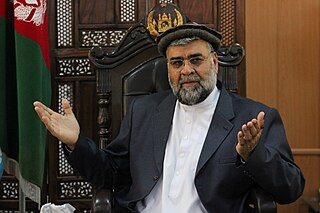Governors
 |
|---|
This is a table chart of the current governors of Afghanistan. Provincial governors are all appointed by the supreme leader of Afghanistan. [1] Provincial governors are often interchanged between provinces and it is not uncommon for the governor of a province to have prior served as provincial governor of multiple provinces.
The current supreme leader of Afghanistan and head of the internationally-unrecognized Taliban government is Mullah Haibatullah Akhundzada.
 |
|---|
The Canadian order of precedence is a nominal and symbolic hierarchy of important positions within the governing institutions of Canada. It has no legal standing, but is used to dictate ceremonial protocol.

Provinces are the most numerous type of province-level divisions in the People's Republic of China (PRC). There are currently 22 provinces administered by the PRC and one province that is claimed, but not administered, which is Taiwan, currently administered by the Republic of China (ROC).
The 2004 Constitution of Afghanistan was the supreme law of the Islamic Republic of Afghanistan, which lasted from 2004 to 2021. It served as the legal framework between the Afghan government and the Afghan citizens. Although Afghanistan was made a state in 1747 by Ahmad Shah Durrani, the earliest Afghan constitutional movement began during the reign of Emir Abdur Rahman Khan in the 1890s followed by the drafting in 1922 of a constitution. The 1964 Constitution of Afghanistan transformed Afghanistan into a modern democracy.

Afghanistan is divided into 34 provinces. The provinces of Afghanistan are the primary administrative divisions. Each province encompasses a number of districts or usually over 1,000 villages.

Iran is subdivided into thirty-one provinces, each governed from a local centre, usually the largest local city, which is called the capital of that province. The provincial authority is headed by a governor-general, who is appointed by the Minister of the Interior subject to approval of the cabinet.

Atta Muhammad Nur is an Afghan exiled politician and former Mujahid Leader who served as the Governor of Balkh Province in Afghanistan from 2004 to January 25, 2018. An ethnic Tajik, he worked to educate the Mujahideen after the 1979 Soviet invasion of Afghanistan, gaining the nickname "The Teacher". He then became a mujahideen resistance commander for the Jamiat-e Islami against the Soviets.
The judiciary of Afghanistan currently consists of the Supreme Court, appeals courts, civil courts and city courts. All justices of the appeals, civil and city courts are presided over by Chief Justice of the Supreme Court.

Fazlullah Mujadedi also known as Abdul Hameed Mujadedi or Abdul Hameed Fazlullah Mujadedi was an Afghan politician in Afghanistan, previously serving as Governor of Logar, Laghman and Takhar provinces. He was one of the prominent commanders of Jamiat-e Islami during the 1980s Soviet–Afghan War. He was amongst the earliest generation of anti-Soviet fighters from Kabul University, which included Amin Wardak, Zabihullah of Marmul in Balkh and Ahmad Shah Massoud.

The Governor of Punjab is the appointed head of state of the provincial government in Punjab, Pakistan. Although the Governor is the head of the province on paper, it is largely a ceremonial position; and the main powers lie with the Chief Minister of Punjab and Chief Secretary of Punjab.
The law in Afghanistan is the uncodified Sharia, interpreted according to the Hanafi jurisprudential school. The ruling Taliban has maintained a strict Hanafi-only approach, ignoring enumeration of international rights, that bears greater similarity to Iran and its "Ja'fari only" jurisprudential stance than countries like Pakistan which follow a non-exclusive parliamentary approach to Islamic law. Whilst opposing codification, in the past, the Taliban written policy has instructed judiciary to consult the Mecelle, a late Ottoman codification of Hanafi Mu'amalat, in matters of civil law.

Provinces of Nepal officially the Autonomous Nepalese Provinces were formed on 20 September 2015 in accordance with Schedule 4 of the Constitution of Nepal. The seven provinces were formed by grouping the existing districts. The current system of seven provinces replaced an earlier system where Nepal was divided into 14 administrative zones which were grouped into five development regions.
The government of Afghanistan, officially called the Islamic Emirate of Afghanistan and informally known as the Taliban government, is the central government of Afghanistan, a unitary state. Under the leadership of the Taliban, the government is a theocracy and an emirate with political power concentrated in the hands of a supreme leader and his clerical advisors, collectively referred to as the Leadership. The Leadership makes all major policy decisions behind closed doors, which are then implemented by the country's civil service and judiciary. As Afghanistan is an Islamic state, governance is based on Sharia law and Pashtunwali, which the Taliban enforces strictly through extensive social and cultural policies.
Mullah Mohammad Shoaib Risalat, alternatively Damullah Mohammad Shoai Risalat, is an Afghan Taliban leader who is currently serving as governor of Samangan Province, Afghanistan.
Qari Mohammad Ayub Khalid is an Afghan Taliban leader who is currently serving as the provincial governor of Afghanistan's northeastern Badakhshan Province.